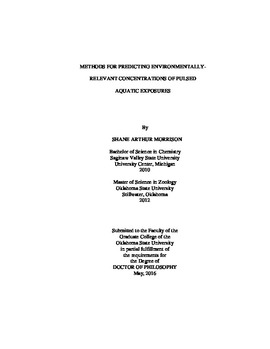| dc.contributor.advisor | Belden, Jason B. | |
| dc.contributor.author | Morrison, Shane Arthur | |
| dc.date.accessioned | 2017-02-22T22:10:15Z | |
| dc.date.available | 2017-02-22T22:10:15Z | |
| dc.date.issued | 2016-05 | |
| dc.identifier.uri | https://hdl.handle.net/11244/48852 | |
| dc.description.abstract | Most current-use pesticides have short half-lives in the water column and thus the most relevant exposure scenarios for many aquatic organisms are pulsed exposures. However, it is frequently challenging to measure exposure due to rapid dissipation of contaminants from water and reduced bioavailability. Therefore, my objective was to evaluate methods for measuring environmentally-relevant exposures associated with pulsed events. The first study utilized a modeling approach to compare the effectiveness of discrete verses integrative sampling methods for predicting toxicologically-relevant pulsed concentrations. Differences between discrete point samples and integrative samples were highest at low sampling frequencies where discrete point samples required higher sampling frequencies to ensure median values > 50% and no sampling events reporting < 10% of the true 96-h time-weighted average concentration as compared to integrative methods. The second study implemented a biomonitoring approach using Helisoma trivolvis snail tissue residues to predict fungicide water concentrations. Although snails have high fungicide tolerance and tissue resides can be detected long after water concentrations drop below detection limits, passive elimination means that residues can only be used to assess whether exposure has occurred. Integrative sampling methods that continuously sample freely dissolved contaminants over time intervals (such as integrative passive samplers) have been demonstrated to be a promising measurement technique. Three different integrative passive sampler configurations were evaluated under different flow and pulsed exposure conditions for measurement of current-use pesticides (n=19), polyaromatic hydrocarbons (n=10), and personal care products (n=5). Results show that reducing membrane limitations allowed for rapid, integrative accumulation of analytes spanning a broad range of hydrophobicities (log Kow 1.5-7.6) even under pulsed conditions. The consequence of reducing membrane limitation was that sampling rates became flow dependent. As such, the last study evaluated various performance reference compounds (PRCs) as methods for in-situ flow corrections for analyte accumulation. Results suggested that multiple PRCs may be required to account for a wide range of flow dependencies. Additionally, although PRC corrections reduced the variability when in-situ conditions differed from laboratory calibrations (e.g. static verses moderate flow), applying PRC corrections under similar flow conditions increases variability in estimated values. | |
| dc.format | application/pdf | |
| dc.language | en_US | |
| dc.rights | Copyright is held by the author who has granted the Oklahoma State University Library the non-exclusive right to share this material in its institutional repository. Contact Digital Library Services at lib-dls@okstate.edu or 405-744-9161 for the permission policy on the use, reproduction or distribution of this material. | |
| dc.title | Methods for predicting environmentally-relevant concentrations of pulsed aquatic exposures | |
| dc.contributor.committeeMember | Dzialowski, Andrew R. | |
| dc.contributor.committeeMember | McMurry, Scott T. | |
| dc.contributor.committeeMember | Storm, Daniel E. | |
| osu.filename | Morrison_okstate_0664D_14565.pdf | |
| osu.accesstype | Open Access | |
| dc.type.genre | Dissertation | |
| dc.type.material | Text | |
| thesis.degree.discipline | Zoology | |
| thesis.degree.grantor | Oklahoma State University | |
